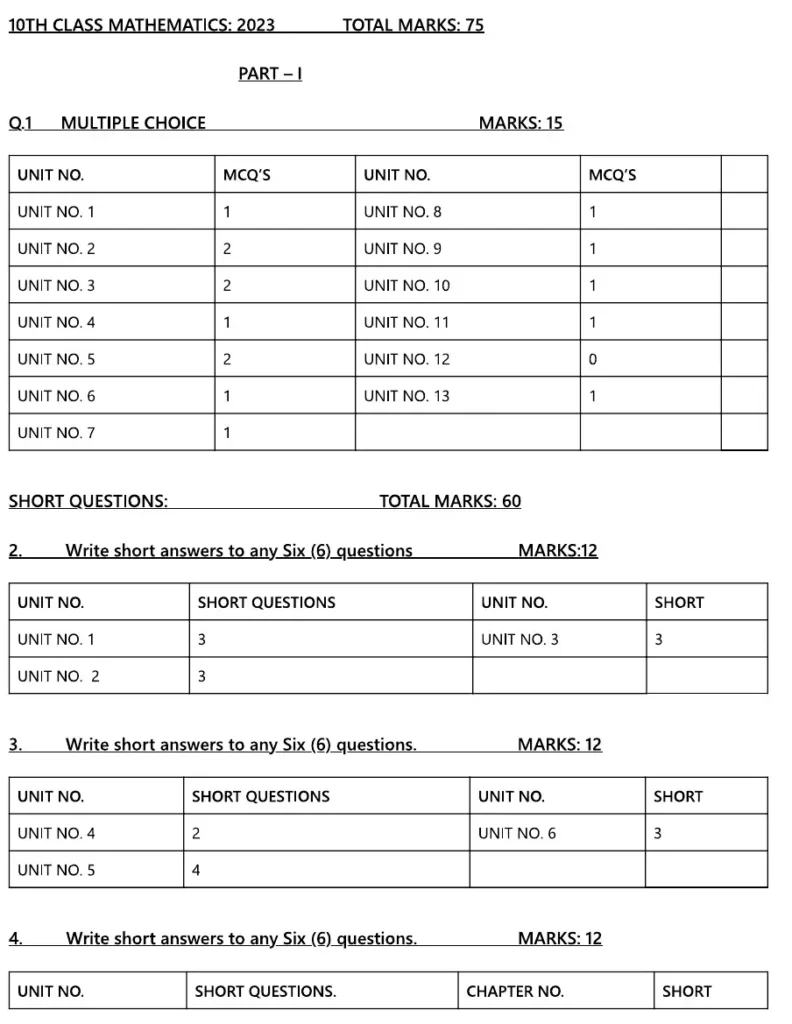10th Class Pairing Scheme for All Subjects 2025
The 10th class pairing scheme for all subjects 2025 is an essential tool for students preparing for their board exams. Whether you are studying science, arts, or commerce, understanding the pairing scheme can significantly improve your preparation. This guide provides detailed insights into the pairing scheme, its importance, and how you can use it effectively to ace your exams.
What is a Pairing Scheme?
A pairing scheme, also known as the paper scheme or assessment scheme, outlines the distribution of questions, chapters, and marks in an exam. It helps students understand:
- Chapter Weightage: Which chapters carry more marks.
- Question Distribution: How objective, short, and long questions are divided among chapters.
- Exam Structure: The format of the paper, including multiple-choice questions (MCQs), short-answer questions (SAQs), and long-answer questions (LAQs).

10th Class Pairing Scheme for All Subjects 2025
Benefits of the Pairing Scheme
The pairing scheme offers multiple benefits to students:
- Focused Preparation: Helps identify high-weightage chapters for targeted study.
- Time Management: Enables efficient allocation of study hours.
- Stress Reduction: Provides clarity on exam patterns, reducing uncertainty.
- Improved Performance: Increases the chances of scoring higher by prioritizing key topics.
Subjects Covered in the Pairing Scheme
The 10th class pairing scheme for all subjects 2025 includes all major subjects taught under the Punjab Boards. These subjects are:
Science Group
- Physics
- Chemistry
- Biology (or Computer Science for students who opted for it)
- Mathematics
Arts Group
- General Mathematics
- Civics
- Economics
- History
Compulsory Subjects
- English
- Urdu
- Islamiyat
- Pakistan Studies
10th Class Pairing Scheme for All Subjects 2025
Detailed Pairing Schemes for Key Subjects
Physics Pairing Scheme
Physics is a conceptual subject requiring understanding of formulas, theories, and numerical problems. The pairing scheme typically divides the chapters as follows:
- MCQs: Each chapter contributes 1-2 MCQs.
- Short Questions: Selected from all chapters, ensuring even coverage.
- Long Questions: Usually combines theoretical and numerical parts from specific chapters.
Example:
- Chapter 1: 2 MCQs, 3 short questions, 1 part of a long question.
- Chapter 5: 1 MCQ, 2 short questions, 1 long question.
Chemistry Pairing Scheme
Chemistry involves theoretical concepts and chemical equations. The scheme is structured to include:
- MCQs: Covering basic definitions and concepts.
- Short Questions: Focused on chemical reactions and processes.
- Long Questions: Combining equations and explanations.
Example:
- Chapter 2: 1 MCQ, 2 short questions, 1 long question.
- Chapter 7: 2 MCQs, 3 short questions, 1 part of a long question.
Mathematics Pairing Scheme
Mathematics requires practice and familiarity with formulas. The pairing scheme includes:
- MCQs: Based on definitions, theorems, and formulas.
- Short Questions: Solved problems from selected exercises.
- Long Questions: Detailed solutions from specific chapters.
Example:
- Chapter 4: 1 MCQ, 2 short questions, 1 long question.
- Chapter 10: 1 MCQ, 1 short question, 1 long question.
10th Class Pairing Scheme for All Subjects 2025
English Pairing Scheme
The English exam focuses on comprehension, grammar, and writing skills. The scheme includes:
- MCQs: Synonyms, antonyms, and grammar rules.
- Short Questions: From the textbook lessons.
- Long Questions: Essay writing, story writing, and application/letter writing.
Example:
- Essay Writing: Topics based on the syllabus.
- Grammar: 5 MCQs from tenses, parts of speech, and sentence correction.
Pakistan Studies Pairing Scheme
This subject covers history, geography, and current affairs. The pairing scheme includes:
- MCQs: Important dates, events, and terminologies.
- Short Questions: Based on chapters’ key points.
- Long Questions: Analytical questions requiring detailed answers.
Example:
- Chapter 2: 2 MCQs, 3 short questions, 1 long question.
- Chapter 4: 1 MCQ, 2 short questions, 1 long question.
10th Class Pairing Scheme for All Subjects 2025
How to Use the Pairing Scheme Effectively
To make the most of the pairing scheme, follow these steps:
- Download the Latest Scheme: Obtain the 2025 pairing scheme from your board’s official website.
- Highlight Important Chapters: Focus on chapters with high weightage.
- Practice According to the Pattern: Solve past papers and sample questions using the scheme as a guide.
- Revise Smartly: Prioritize topics that appear in multiple sections (e.g., both MCQs and long questions).
FAQs About the 10th Class Pairing Scheme for all subjects
Q1: Where can I find the official pairing scheme for 2025?
A: You can download it from your respective board’s official website.
Q2: Is the pairing scheme the same for all Punjab boards?
A: Yes, the PBCC ensures a uniform pairing scheme across all Punjab boards.
Q3: Can the pairing scheme change?
A: Minor adjustments might occur, so always refer to the updated scheme.
Q4: How accurate is the pairing scheme?
A: It’s designed to closely align with the exam paper but should be used alongside thorough preparation.
Final Thoughts
The 10th class pairing scheme for all subjects 2025 is an invaluable resource for strategic exam preparation. By understanding the distribution of questions and marks, students can focus on high-priority areas and maximize their scores. Be sure to use the scheme as a complementary tool, alongside consistent study and practice.
Stay focused, plan effectively, and good luck with your exams!